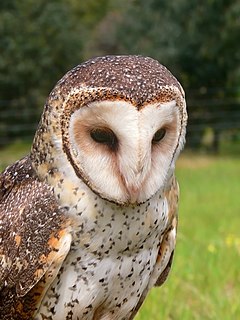
Barn-owls are one of the two families of owls, the other being the true owls or typical owls, Strigidae. They are medium to large owls with large heads and characteristic heart-shaped faces. They have long, strong legs with powerful talons. They also differ from the Strigidae in structural details relating in particular to the sternum and feet.
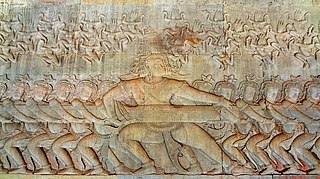
Asuras are a class of beings in Indian religions. They are described as power-seeking clans related to the more benevolent Devas in Hinduism. In its Buddhist context, the word is sometimes translated "titan, "demigod", or "antigod".
Hindu deities are the gods and goddesses in Hinduism. The terms and epithets for deity within the diverse traditions of Hinduism vary, and include Deva, Devi, Ishvara, Ishvari, Bhagavān and Bhagavati.
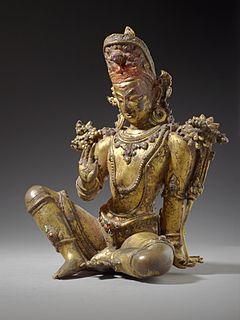
Deva means "heavenly, divine, anything of excellence", and is also one of the terms for a deity in Hinduism. Deva is a masculine term; the feminine equivalent is Devi.

A daeva is a Zoroastrian supernatural entity with disagreeable characteristics. In the Gathas, the oldest texts of the Zoroastrian canon, the daevas are "gods that are rejected". This meaning is – subject to interpretation – perhaps also evident in the Old Persian "daiva inscription" of the 5th century BCE. In the Younger Avesta, the daevas are divinities that promote chaos and disorder. In later tradition and folklore, the dēws are personifications of every imaginable evil.

The Aptian is an age in the geologic timescale or a stage in the stratigraphic column. It is a subdivision of the Early or Lower Cretaceous epoch or series and encompasses the time from 125.0 ± 1.0 Ma to 113.0 ± 1.0 Ma, approximately. The Aptian succeeds the Barremian and precedes the Albian, all part of the Lower/Early Cretaceous.

The Samudra Manthana is one of the best-known episodes in the Hindu philosophy narrated in the Bhagavata Purana, in the Mahabharata and in the Vishnu Purana. The Samudra Manthana explains the origin of Amrita.

An asura in Buddhism is a demigod or titan of the Kāmadhātu. They are described as having three heads with three faces each and either four or six arms.

Eurybia furcata, commonly called forked aster, is an herbaceous perennial in the composite family. It is native primarily to the Great Lakes region and the Ozark Mountains in the United States. It is uncommon throughout its range, and occurs in the states of Michigan and Wisconsin in the north, south through Nebraska, Illinois, Iowa, and Indiana, and into Missouri and Arkansas. The species is intolerant of shade and is typically found on rocky, north-facing slopes, especially those composed of limestone, dolomite, or sandstone. It can also be found in seeps on bluffs, in moist woods along streams, and occasionally in disturbed sites. It is included in the Center for Plant Conservation's National Collection of Endangered Plants.

Choaspes furcata, the hooked awlking, is a butterfly belonging to the family Hesperiidae.

Asura is a genus of moths in the subfamily Arctiinae erected by Francis Walker in 1854.

Asura's Wrath is an action video game developed by CyberConnect2 and published by Capcom. Asura's Wrath was first announced at the Tokyo Game Show in 2010, and was released worldwide in February 2012. The game is playable on PlayStation 3, Xbox 360, Xbox One & Xbox Series X/S via 360 backwards compatibility, and the PlayStation 4 and PC via PlayStation Now.
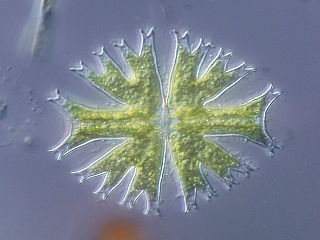
Micrasterias furcata is a species of freshwater single-celled desmid. M. furcata is round, flattened and lobed in body plan.
Asura strigipennis is a moth of the family Erebidae. It was described by Gottlieb August Wilhelm Herrich-Schäffer in 1914. It is found on Java, Sumatra and in China, Taiwan and India.
Asura avernalis is a moth of the family Erebidae. It is found on the Solomon Islands and Bougainville Island.
Asura quadrilineata is a moth of the family Erebidae. It is found on Aru and in Australia.

Cyme sexualis is a moth of the subfamily Arctiinae first described by Felder in 1864. It is found on Ambon, Sulawesi, the Dampier Archipelago. and in New Guinea.
Cyme basitesselata is a moth of the subfamily Arctiinae.
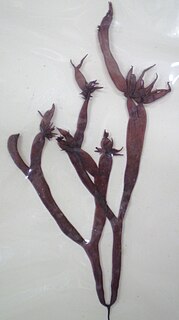
Gloiopeltis furcata, commonly known as glueweed, jelly moss and fukuro-funori (Japan), is a marine alga that is widely distributed in the North Pacific Ocean, along the shorelines of China, Taiwan, Korea, Japan, and the Pacific shores of Russia; and from the Aleutian Islands south to Baja California. G. furcata has long been utilized as a food source in Asia, where it is also used as a sizing material in silk and other textiles. G. furcata is also a raw material for textile binders. Studies show that extracts of G. furcata inhibit the growth of several human cancer cell lines, and can significantly lower blood glucose levels.
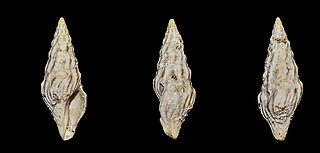
Crassispira furcata is an extinct species of sea snail, a marine gastropod mollusk in the family Pseudomelatomidae, the turrids and allies. Fossils have been found in Eocene strata in the Paris Basin, France.













